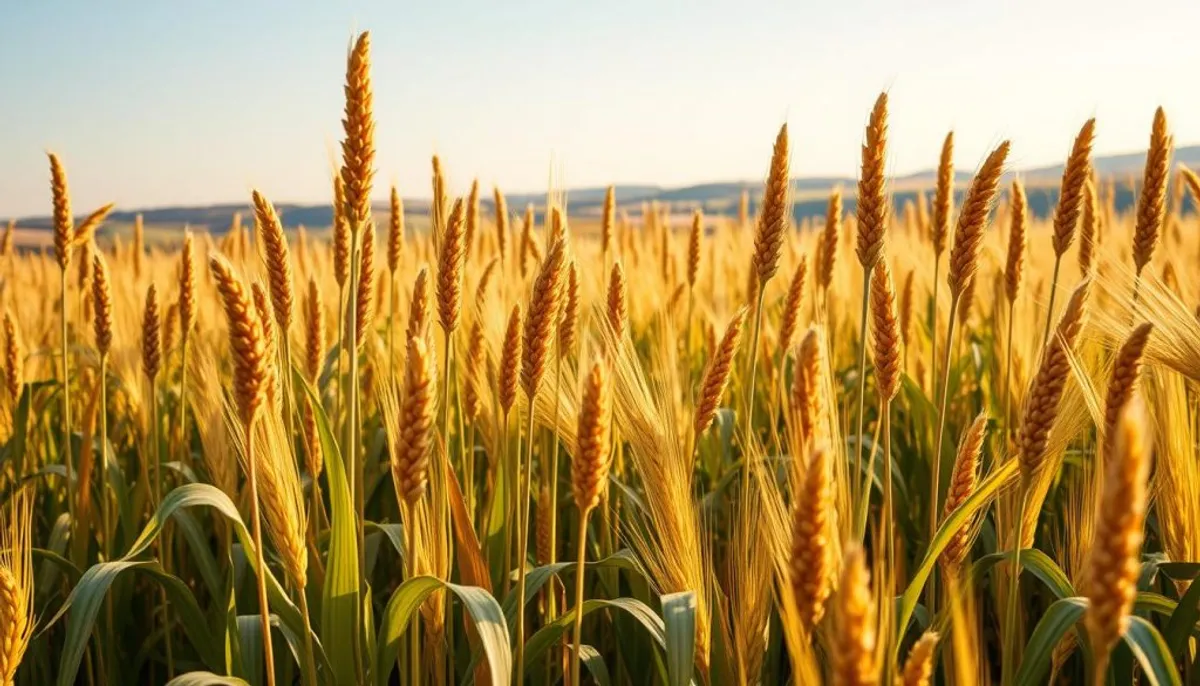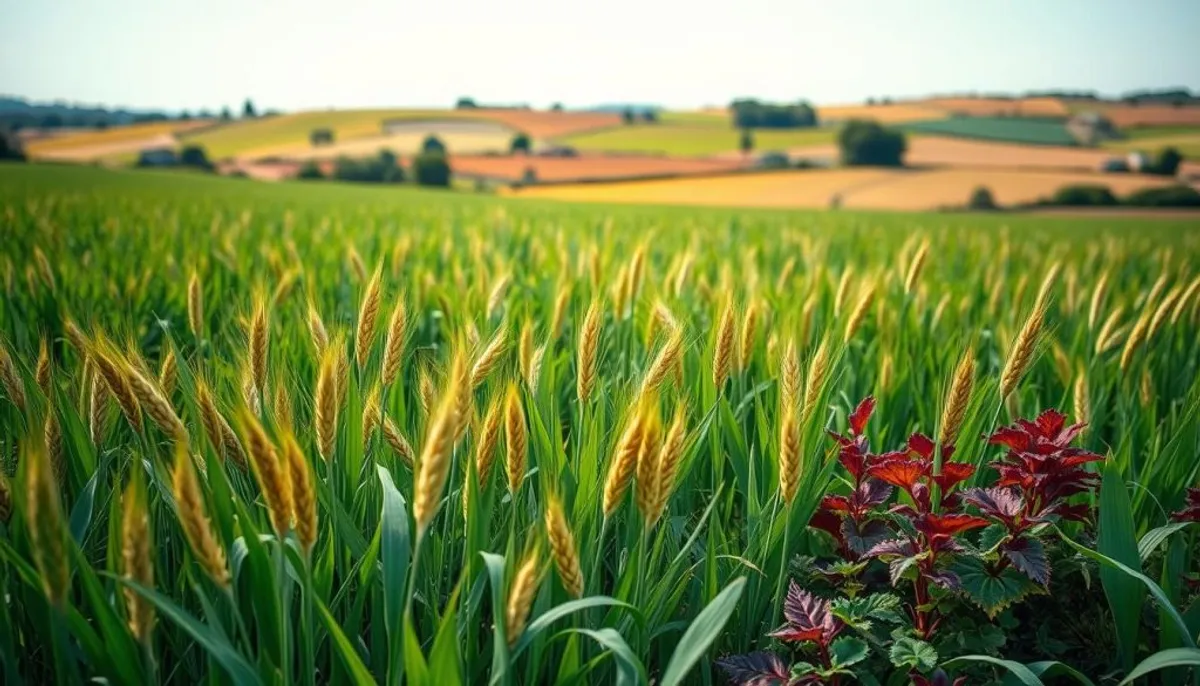The choice of the crop to sow after triticale is essential for optimizing rotations and preserving soil health. This cereal, a result of the crossbreeding between wheat and rye, has unique characteristics. It offers a theoretical yield of 70 quintals per hectare, combining the productivity of wheat with the hardiness of rye.
The crop rotation after triticale requires particular attention. This cereal requires 20 to 25% less nitrogen than wheat, influencing the nutritional needs of the following crop. Its cold resistance, sensitive to -10°C, allows for great flexibility in sowing dates, generally between June and September.

To determine which crop after triticale, several factors must be considered. The sowing density, which should not exceed 85% of the recommendations for soft wheat, influences the soil structure. The contributions of phosphorus and potassium vary according to soil quality, ranging from 30 to 60 kg/ha, impacting the fertility for the next crop.
By considering these elements, we will explore the best crop options to sow after triticale. We will also discuss practices to avoid in order to maximize yields and maintain the balance of your fields.
Understanding the characteristics of triticale as a preceding crop
Triticale, the result of the union between wheat and rye, is distinguished by its unique traits. These characteristics make triticale a valuable choice for crop succession. Its robustness and adaptability play a crucial role in this succession.
The hardiness inherited from rye
Triticale is characterized by its great robustness. It excels in various environments, producing up to 80 grains per spike. Its straw productivity exceeds that of wheat by 50%, providing a significant advantage to farmers.

Impact on soil structure
The root system of triticale improves soil structure. It promotes aeration and water retention, beneficial for subsequent crops. Moreover, triticale is less prone to lodging than wheat, thus facilitating harvesting.
Effects on the nitrogen needs of subsequent crops
Triticale requires less nitrogen than soft wheat, at 2.6 kg per quintal. This efficiency reduces the fertilization needs of subsequent crops. Farmers observe savings of about 30 nitrogen units compared to wheat, influencing the planning of crop succession.
| Characteristic | Triticale | Soft Wheat |
|---|---|---|
| Nitrogen requirement (kg/quintal) | 2.6 | 3 |
| Straw productivity | +50% | Reference |
| Susceptibility to lodging | Low | Higher |
Which crop after triticale: the best options
Choosing the right crop after triticale is essential for effective rotation. It is imperative to select alternatives that promote soil health and increase yields, while also seeking to improve children's knowledge of sustainable agriculture.
Recommended crops after triticale
Legumes prove to be ideal choices to replace triticale. They benefit from the improved soil structure and provide nitrogen. Forage peas, sown at 30-40 kg/ha, are a promising option. Similarly, purple clover, sown at 8-10 kg/ha, enriches the soil.
Crops to avoid and contraindicated
It is wise to avoid straw cereals, such as wheat or barley, after triticale. These crops consume the same soil resources and may increase the risk of diseases. Sugar beets should also be avoided due to the risk of nematodes.

Importance of return intervals in rotation
It is crucial to respect return intervals for soil health. An interval of 2 to 3 years is recommended before reintroducing triticale into the rotation. This strategy breaks the cycles of pests and diseases, thus ensuring better long-term yields.
| Crop | Sowing rate (kg/ha) | Price (€/kg) |
|---|---|---|
| Forage peas | 30-40 | 1.00-1.50 |
| Purple clover | 8-10 | 4.00-6.00 |
| Triticale | 80-100 | 60-80 |
Key factors for successful crop succession
The planning of triticale cropping requires careful attention to several crucial aspects. These elements are essential for optimizing the crop succession of triticale and ensuring sustainable production. For this, it is helpful to follow practical advice for stopping cultivation and training.
Management of crop residues
Triticale generates significant biomass, leaving the plot clean. Its straw, rich in carbon, can be used as mulch. This method stimulates the biological activity of the soil and increases its organic matter content. For effective coverage, it is necessary to have at least 8 tons of dry matter per hectare.
Soil preparation for the next crop
The soil structure after triticale is generally favorable. Conservation agriculture is recommended to preserve these advantages. It reduces soil tillage and maintains permanent cover. This strategy decreases erosion and improves water retention.
Adaptation to pedoclimatic conditions
The choice of the next crop must be adapted to the climate and soil type. In dry regions, prioritize drought-resistant crops. In heavy soils, opt for deep-rooted plants. Irrigation may be necessary for certain crops, such as soybeans.
| Factor | Impact on crop succession | Recommendation |
|---|---|---|
| Triticale residues | Enrichment of soil organic matter | Use as mulch |
| Soil structure | Improvement of water retention | Limit soil tillage |
| Climate | Influences the choice of subsequent crops | Adapt according to the region |
Optimizing rotations including triticale
The triticale cropping planning is crucial for optimizing agronomic and economic benefits. Triticale, with its robustness, adapts well to different cropping rotations. Its ability to structure the soil and leave a clean soil after harvest makes it an excellent precursor for multiple crops.
The inclusion of legumes in the rotations after triticale is highly recommended. They enrich the soil with nitrogen, benefiting subsequent crops. In organic farming, legumes are mandatory in multi-annual rotations.
| Year | Main crop | Intercrop |
|---|---|---|
| 1 | Triticale | Leguminous cover crop |
| 2 | Corn or Sunflower | – |
| 3 | Soybean or Lentil | – |
| 4 | Wheat or Mixed crop | Cover crop |
| 5 | Triticale | – |
This rotation alternates between winter and spring crops, promoting diversity and reducing weed pressure. The addition of nitrate-trapping cover crops (CIPAN) improves soil fertility and prevents nitrogen leaching.
It is essential to adjust crop choices to local conditions and the goals of the farm. Multi-year contracts with market operators can ensure outlets, especially for crops like triticale, which is in increasing demand.
Conclusion
Optimizing crop rotation after triticale is essential. Triticale, resulting from the crossbreeding between rye and wheat, offers notable advantages. It improves soil structure and influences the nitrogen needs of subsequent crops. For those who wish to succeed, it is important to follow advice to prepare for a general culture quiz.
For a successful crop succession after triticale, it is crucial to manage residues and prepare the soil carefully. Farmers must consider the pedoclimatic conditions of their farm. For example, on a 100-hectare farm like that of Damien Bourgy, a basic 4-year rotation can be adapted. This rotation includes beets, wheat, rapeseed-fava bean, and wheat, with the integration of triticale.
Optimizing rotations with triticale brings considerable benefits. The experience of Franck Radina shows that using legumes as cover before wheat reduces nitrogen needs by 40% to 75% for wheat crops. This method aligns with sustainable agriculture, reducing inputs while maintaining productivity.
In conclusion, the choice of crop after triticale should be a component of a comprehensive crop rotation strategy. Thoughtful planning contributes to more resilient and economically viable agriculture. It also helps preserve soil fertility in the long term.
RelatedRelated articles


